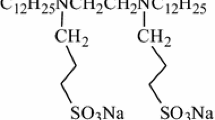Abstract
In surfactant-activated electrorheological (ER) suspensions, the ER response shows linear ER behavior (Τ∞E 2o at small surfactant concentrations and nonlinear ER behavior (Τ∞E no ,n>2) at large surfactant concentrations. A surfactant bridge model was proposed to explain the nonlinear ER behavior at large surfactant concentrations with some assumptions. The proposed model successfully predicted the qualitative nonlinear ER behavior of surfactant-activated ER suspensions at large surfactant concentrations. Here, the surfactant bridge model is expanded to predict the electric field frequency dependent ER behavior of surfactant-activated ER suspensions. The developed surfactant bridge model can predict both the linear ER behavior at small surfactant concentrations and the nonlinear ER behavior at large surfactant concentrations. Furthermore, this model can predict two different types of the electric field frequency dependent ER behaviors of surfactant-activated ER suspensions, which depend on the amount of surfactants.
Similar content being viewed by others
References
Block, H. and Kelly, J. P., “Electro-rheology,”J. Phys. D: Appl. Phys.,21, 1661 (1988).
Chin, B. D. and Park, O. O., “Electrorheological Response of Particulate Suspensions and Emulsions in a Small-strain Shear Flow: Viscoelasticity and Yield Phenomena,”Korean J. Chem. Eng.,18, 54 (2001).
Choi, H. J., Cho, M. S., Kim, J. W., Kim, C. A. and Jhon, M. S., “A Yield stress Scaling Function for Electrorheological Fluids,”Appl. Phys. Lett.,78, 3806 (2001).
Deinega, Y. F. and Vinogradov, G. V, “Electric Fields in the Rheological Disperse System,”Rheol. Acta,23, 636 (1984).
Gast, A. P. and Zukoski, C. F, “Electrorheological Fluids as Colloidal Suspensions,”Adv. Coll. Int. Sci.,30, 153 (1989).
Goodwin, J. W., Markham, G. M. and Vincent, B., “Studies on Model Electrorheological Fluids,”J. Phys. Chem. B,101, 1961 (1997).
Jackson, J. D., “Electrodynamics,” 2nd ed. John Wiley and Sons, Inc. (1975).
Jones, T. B. and Kallio, G. A., “Dielectrophoretic Levitation of Spheres and Shells,”J. Electrostatics,6, 207 (1979).
Jordan, T. C. and Shaw, M. T., “Electrorheology,”IEEE Trans. Elect. Insul.,24, 849 (1989).
Kim, Y D. and Klingenberg, D. J., “Two Roles of Nonionic Surfactants on the Electrorheological Response,”J. Colloid Interface Sci,183, 568 (1996).
Kim, Y D., “A surfactant Bridge Model for the Nonlinear Electrorheological Effects of Surfactant-Activated ER Suspensions,”J. Colloid Interface Sci.,236, 225 (2001).
Kim, Y D. and Park, D. H., “The Electrorheological Responses of Suspensions of Polypyrrole-coated Polyethylene Particles,”Coll. Pol. Sci.,280, 828 (2002a).
Kim, Y D. and Park, D. H., “The Electrorheological and Dielectric Behaviors of Conducting Polymercoated Poly(ethyl mathacrylate) Suspensions,”Macromolecular Research,10, 215 (2002b).
Kim, Y D., Choi, G. J., Sim, S. J. and Cho, Y S., “Electrorheological Suspensions of Two Polarizable Particles,”Korean J. Chem. Eng.,16, 338 (1999).
Kim, Y D. and Song, I. C., “Electrorheological and Dielectric Properties of Polypyrrole Dispersions,”J. Materials Sci.,37, 5051 (2002).
Klingenberg, D. J. and Zukoski, C. F, “Studies on the Steady-shear Behavior of Electrorheological Suspensions,”Langmuir,6, 15 (1990).
Mason, G. and Clark, W. C, “Liquid Bridges between Spheres,”Chem. Eng. Sci.,20, 859 (1965).
Myers, D., “Surfaces, Interfaces, and Colloids: Principles and Applications,” VCH Pub. Weinheim (1991).
Parthasarathy, M. and Klingenberg, D. J., “Electrorheology: Mechanisms and Models,”Mater. Sci. and Eng. Rep.,R17, 57 (1996).
Petrzhik, G. G., Chertkova, O. A. and Trapeznikov, A. A., “Electrorheological Effect in Nonaqueous Dispersions of Various Compositions in Relation to the Electric Field Parameters,”Dokl. Akad. Nauk SSSR,253, 173 (1980).
Pohl, H. A. and Crane, J. S., “Dielectrophoretic Force,“J. Theor. Biol,37, 1 (1972).
Rosen, M. J., “Surfactants and Interfacial Phenomena,” 2nd. ed. Wiley, New York (1989).
Sher, L. D., “Dielectrophoresis in Lossy Dielectric Media,”Nature,220, 695 (1968).
Shulman, Z. P., Gorodkin, R G., Korobko, E. V. and Gleb, V. K, “The Electrorheological Effects and Its Possible Uses,”J. Non-Newt. Fluid Mech.,8, 29 (1981).
Trapeznikov, A. A., Petrzhik, G G. and Chertkova, O. A, “Electrorheological Properties of Nonaqueous Dispersions of Titanium Dioxide and Silicone Dioxide in Relation to Concentration and Moisture Content of Filler,”Koll. Zhurn.,43, 1134 (1981).
Weiss, K. D. and Carlson, J. D., “Material Aspects of Electrorheological Systems,”J. Intell. Sys. and Struct.,4, 13 (1993).
Winslow, W M., “Induced Fibration of Suspensions,”J. Appl. Phys.,20, 1137 (1949).
Author information
Authors and Affiliations
Corresponding author
Rights and permissions
About this article
Cite this article
Kim, Y.D., Lee, M.S. A frequency-dependent surfactant bridge model for the electrorheological behaviors of surfactant-activated suspensions. Korean J. Chem. Eng. 21, 567–574 (2004). https://doi.org/10.1007/BF02705489
Received:
Accepted:
Issue Date:
DOI: https://doi.org/10.1007/BF02705489




